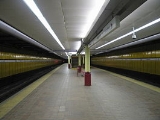
Anderston railway station
Encyclopedia
Anderston railway station serves Glasgow
's Financial district of Anderston
and, across the M8 motorway, the housing schemes of Anderston West. It is a manned station with an island platform
and most of it is underground.
, then by Caledonian Railway
, it became part of the London, Midland and Scottish Railway
during the Grouping
of 1923. The station then passed on to the Scottish Region of British Railways
on nationalisation in 1948. It was then closed by the British Transport Commission
Reopened by the British Railways Board
and Strathclyde PTE, when Sectorisation
was introduced in the 1980s, the station was served by ScotRail
under arrangement with the PTE until the Privatisation of British Rail
ways.
The original building was demolished in 1968 as, like many other ornate and historical buildings in the area, it lay in the path of the M8 motorway. The station, reopened as part of the Argyle Line
project on 5 November 1979, retains some of the original architecture at platform level.
Ticket barriers came into operation on 22 June 2011.
Glasgow
Glasgow is the largest city in Scotland and third most populous in the United Kingdom. The city is situated on the River Clyde in the country's west central lowlands...
's Financial district of Anderston
Anderston
Anderston is a district in the Scottish city of Glasgow. It is on the north bank of the River Clyde and extends to the western edge of the city centre...
and, across the M8 motorway, the housing schemes of Anderston West. It is a manned station with an island platform
Island platform
An island platform is a station layout arrangement where a single platform is positioned between two tracks within a railway station, tram stop or transitway interchange...
and most of it is underground.
History
The station was opened on 10 August 1896, closing on 3 August 1959. Opened by the Glasgow Central RailwayGlasgow Central Railway
The Glasgow Central Railway was a railway that ran from Maryhill in the north west of Glasgow through the West End and City Centre to Rutherglen and Newton to the south east of the city.- Early days :...
, then by Caledonian Railway
Caledonian Railway
The Caledonian Railway was a major Scottish railway company. It was formed in the early 19th century and it was absorbed almost a century later into the London, Midland and Scottish Railway, in the 1923 railway grouping, by means of the Railways Act 1921...
, it became part of the London, Midland and Scottish Railway
London, Midland and Scottish Railway
The London Midland and Scottish Railway was a British railway company. It was formed on 1 January 1923 under the Railways Act of 1921, which required the grouping of over 120 separate railway companies into just four...
during the Grouping
Railways Act 1921
The Railways Act 1921, also known as the Grouping Act, was an enactment by the British government of David Lloyd George intended to stem the losses being made by many of the country's 120 railway companies, move the railways away from internal competition, and to retain some of the benefits which...
of 1923. The station then passed on to the Scottish Region of British Railways
Scottish Region of British Railways
The Scottish Region was one of the six regions created on British Railways and consisted of ex-London, Midland and Scottish Railway and ex-London and North Eastern Railway lines in Scotland...
on nationalisation in 1948. It was then closed by the British Transport Commission
British Transport Commission
The British Transport Commission was created by Clement Attlee's post-war Labour government as a part of its nationalisation programme, to oversee railways, canals and road freight transport in Great Britain...
Reopened by the British Railways Board
British Railways Board
The British Railways Board was a nationalised industry in the United Kingdom that existed from 1962 to 2001. From its foundation until 1997, it was responsible for most railway services in Great Britain, trading under the brand names British Railways and, from 1965, British Rail...
and Strathclyde PTE, when Sectorisation
British Rail brand names
British Rail was the brand image of the nationalised railway owner and operator in Great Britain, the British Railways Board, used from 1965 until its breakup and sell-off from 1993 onwards....
was introduced in the 1980s, the station was served by ScotRail
ScotRail
ScotRail was a brand name used for all Scottish regional and commuter rail services, including some cross-border services, from 1997 to 2004....
under arrangement with the PTE until the Privatisation of British Rail
Privatisation of British Rail
The privatisation of British Rail was set in motion when the Conservative government enacted, on 19 January 1993, the British Coal and British Rail Act 1993 . This enabled the relevant Secretary of State to issue directions to the relevant Board...
ways.
The original building was demolished in 1968 as, like many other ornate and historical buildings in the area, it lay in the path of the M8 motorway. The station, reopened as part of the Argyle Line
Argyle Line
The Argyle Line is a suburban railway located in West Central Scotland. It connects the Lanarkshire towns of Lanark, Larkhall and Motherwell to West Dunbartonshire via central Glasgow using sub-surface running...
project on 5 November 1979, retains some of the original architecture at platform level.
Ticket barriers came into operation on 22 June 2011.

